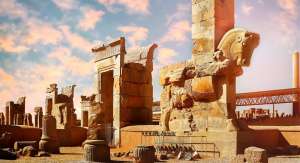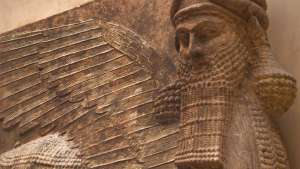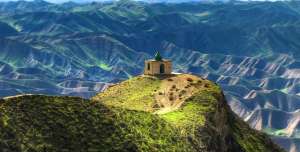Petra is an ancient city that lies in present-day Jordan and dates back to the fourth century B.C. Ruins of the once-great metropolis and trading center now serve as an important archeologic site and tourist attraction. This selection of photos conveys a first impression of ancient Petra, the capital of the Nabataeans. It gives an idea of the wealth of archaeological treasures that can be encountered while walking in the valley basin, through gorges, and over rocks and ridges.
Petra is located about 150 miles south of both Jerusalem and Amman, the capital of Jordan, and about midway between Damascus, Syria, and the Red Sea, making it ideally suited as a hub of commerce in the area.
The site is considered significant by historians and archeologists alike because of its beautiful rock-cut architecture and innovative water management system, the latter of which made the region inhabitable, given that it is surrounded by desert and rugged, mountainous terrain.
Petra has also been referred to as the “Rose City” because of the color of the stones used in its buildings. It was named a UNESCO World Heritage Site in 1985.

The trail to the center of Petra leads first through the Bab as-Siq. Right at the beginning one can see the mysterious Block Tombs. The Aslah Triclinium with the oldest dated inscription of Petra, although easily accessible, is rarely visited.

Obelisk Tomb and Bab as-Siq Triclinium. The two very different rock-cut structures were built at the same time (40 - 70 AD) and functionally coordinated. In the foreground, pit graves on a rock.

The Siq (shaft), the main pathway to Petra, winds over 1.2 km through a cleft in the sandstone massif which in some places is only 3 m wide and up to 70 m deep. On both sides of the path you can see the remains of Nabataean water channels.

Row of votive niches, some with inscriptions, known as Sabinos Alexandros Station. Along the Siq are many other testimonies of the Nabataean religion, including betyls and small incense altars.

The most famous tomb in Petra. Bedouins called it "Khazneh al-Fira'un" (Pharaoh's Treasury, short: al-Khazneh), because they believed that a fleeing Egyptian pharaoh hid a treasure in the urn on the top.

The 25 m wide and 39 m high al-Khazneh was completely hewn out of the rock probably in the 3rd or 4th decade of our era. The main figure is identified, i.a. by the Basileion on the gable below her as the goddess Isis.

Shortly before the theater, smaller tomb facades were chiseled out of the rock in several rows one above the other probably in the 1st century AD. Most of them are Pylon Tombs with single or double crenellations.

The theater was built in the early 1st century AD and was expanded after the Roman annexation of the Nabataean Kingdom in 106 A.D., slicing trough some older tomb facades. Its auditorium could seat up to 8.000 spectators.

Many facades in Petra were part of larger burial complexes, which could include courtyards, colonnades, banquet rooms, cisterns and basins. Some of these can be seen in the Urn Tomb, which was converted into a church in the 5th century.

Overlooking the ancient city center, the so-called "Royal Tombs," carved out of the Jabal al-Khubtha rock massif. The elaborately designed, 49 m wide Palace Tomb is one of the largest monuments in Petra.'

The center of Petra is dominated by the magnificent complex of the so-called Great Temple. In the background you can see the Royal Tombs hewn from the western slope of Jabal al-Khubtha.

The so-called Great Temple was not used for religious worship, but for representative purposes by the Nabataean kings. Built from the end of the 1st century BC onwards, it was extended and rebuilt several times.

Qasr al-Bint Far'un was Petra’s main temple. The name meaning "Castle of the Pharaoh's Daughter" was given to it by the Bedouin. At the end of the Colonnaded Street, a monumental triple-arched gate marks the access to the sacred precinct.

Shortly before the High Place of Sacrifice, workers of the quarry left two more than 6 m high stone monuments, which were completely hewn out of the massive rock. They are nefeshes probably dedicated to a rock deity or in memory of dead colleagues.

The High Place of Sacrifice on top of Jabal al-Madhbah (1072 m) was probably dedicated to Dushara, the main god of the Nabataeans in Petra. In the center is the west facing altar with the so-called god throne. Also ritual banquets took place here.

The upper area of Wadi Farasa East was named "Garden Valley" by the explorer G. Dalman when in spring 1904 he found an idyllic place there. This is where the name Garden Triclinium comes from for the rock monument with the columned portal.

The Soldier Tomb Complex, named after the relief of a man in armor on the facade. The magnificent mausoleum from the 3rd quarter of the 1st century AD was part of an ensemble with a colonnaded courtyard, triclinium and other buildings.

In the most elaborate triclinium of Petra, directly opposite the Soldier's Tomb, ritual banquets were held in honor of the dead. Today one can see the bright colors of the sandstone. Originally the walls were covered with stucco and painted.

This place of worship was given the name Ad Deir (Monastery) because of a cross from the Byzantine period. The 47 x 48 m facade follows the model of the Khazneh (Treasury), but it is not a tomb. Probably the Nabataean king Obodas, who was venerated as a god, was worshipped here.







